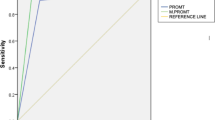Abstract
Objective
To elucidate the role of MRI in predicting meniscal tear reparability according to tear type and location in relation to vascular zones.
Materials and methods
In this retrospective study, two readers evaluated 79 pre-surgical MRIs of meniscal tears arthroscopically treated with meniscectomy or meniscal repair. Tears were classified according to type into vertical, horizontal, radial, complex, flaps and bucket handle and were considered reparable if the distance measured from the tear to the menisco-capsular junction was less than or equal to 5 mm. Predictions were compared with the surgical procedure performed in arthroscopy. We assessed the diagnostic performance of MRI, agreement between MRI and arthroscopy, and interrater agreement. Then, we conducted an ROC analysis on the distances measured by the first reader and built a multivariate logistic regression model.
Results
MRI had a sensitivity, specificity, PPV, NPV and accuracy, respectively, of 85%, 79%, 86%, 76% and 83% in predicting meniscal tear reparability. Correct predictions for the specific tear pattern were 76% for vertical, 84% for horizontal, 88% for radial, 86% for complex, 84% for flaps and 86% for bucket handle. Agreement between the two readers’ predictions and arthroscopy was good (k = 0.65 and 0.61, respectively). Inter-rater agreement was almost excellent (k = 0.79). The ROC analysis revealed sensitivity and specificity of 73% and 83% with a cutoff value of <4 mm (p < 0.001). Anterior cruciate ligament injury and medial meniscal tear increased the likelihood of meniscal tear reparability.
Conclusions
MRI can be a reliable and accurate tool to predict the reparability of meniscal tears, with higher prediction rates for bucket-handle tears.





Similar content being viewed by others
References
Kim S, Bosque J, Meehan JP, Jamali A, Marder R. Increase in outpatient knee arthroscopy in the United States: a comparison of national surveys of ambulatory surgery, 1996 and 2006. J Bone Jt Surg Am [Internet]. 2011;93:994–1000. Available from: http://www.ncbi.nlm.nih.gov/pubmed/21531866
Shybut T, Strauss EJ. Surgical management of meniscal tears. Bull NYU Hosp Jt Dis [Internet]. 2011;69:56–62. Available from: http://www.ncbi.nlm.nih.gov/pubmed/21332440
Arnoczky SP, Warren RF. Microvasculature of the human meniscus. Am J Sport Med [Internet]. 1982;10:90–5. Available from: http://www.ncbi.nlm.nih.gov/pubmed/7081532
Bach BR Jr, Dennis M, Balin J, Hayden J. Arthroscopic meniscal repair: analysis of treatment failures. J Knee Surg [Internet]. 2005;18:278–84. Available from: http://www.ncbi.nlm.nih.gov/pubmed/16262009
Starke C, Kopf S, Petersen W, Becker R. Meniscal repair. Arthroscopy [Internet]. 2009;25:1033–44. Available from: http://www.ncbi.nlm.nih.gov/pubmed/19732643
Noble J. Lesions of the menisci. Autopsy incidence in adults less than fifty-five years old. J Bone Jt. Surg Am [Internet]. 1977;59:480–3. Available from: http://www.ncbi.nlm.nih.gov/pubmed/577209
Lee SJ, Aadalen KJ, Malaviya P, et al. Tibiofemoral contact mechanics after serial medial meniscectomies in the human cadaveric knee. Am J Sport. Med [Internet]. 2006;34:1334–44. Available from: http://www.ncbi.nlm.nih.gov/pubmed/16636354
Mesiha M, Zurakowski D, Soriano J, Nielson JH, Zarins B, Murray MM. Pathologic characteristics of the torn human meniscus. Am J Sport. Med [Internet]. 2007;35:103–12. Available from: http://www.ncbi.nlm.nih.gov/pubmed/17092929
Behairy NH, Dorgham MA, Khaled SA. Accuracy of routine magnetic resonance imaging in meniscal and ligamentous injuries of the knee: comparison with arthroscopy. Int Orthop. 2009;33:961–7.
Bernthal NM, Seeger LL, Motamedi K, et al. Can the reparability of meniscal tears be predicted with magnetic resonance imaging? Am J Sport. Med [Internet]. 2011;39:506–10. Available from: http://www.ncbi.nlm.nih.gov/pubmed/21173193
Matava MJ, Eck K, Totty W, Wright RW, Shively RA. Magnetic resonance imaging as a tool to predict meniscal reparability. Am J Sport. Med [Internet]. 1999;27:436–43. Available from: http://www.ncbi.nlm.nih.gov/pubmed/10424212
Nourissat G, Beaufils P, Charrois O, et al. Magnetic resonance imaging as a tool to predict reparability of longitudinal full-thickness meniscus lesions. Knee Surg Sport Traumatol Arthrosc [Internet]. 2008;16:482–6. Available from: http://www.ncbi.nlm.nih.gov/pubmed/18292991
Shiozaki Y, Horibe S, Mitsuoka T, Nakamura N, Toritsuka Y, Shino K. Prediction of reparability of isolated semilunar lateral meniscus tears by magnetic resonance imaging. Knee Surg Sport. Traumatol Arthrosc [Internet]. 2002;10:213–7. Available from: http://www.ncbi.nlm.nih.gov/pubmed/12172713
Thoreux P, Rety F, Nourissat G, et al. Bucket-handle meniscal lesions: magnetic resonance imaging criteria for reparability. Arthroscopy [Internet]. 2006;22:954–61. Available from: http://www.ncbi.nlm.nih.gov/pubmed/16952724
Cohen J. A coefficient of agreement for nominal scales. Educ Psychol Meas. 1960;20:37–46.
Landis JR, Koch GG. The measurement of observer agreement for categorical data. Biometrics [Internet]. 1977;33:159–74. Available from: http://www.ncbi.nlm.nih.gov/pubmed/843571
Hutchinson ID, Moran CJ, Potter HG, Warren RF, Rodeo SA. Restoration of the meniscus: form and function. Am J Sport. Med [Internet]. 2014;42:987–98. Available from: http://www.ncbi.nlm.nih.gov/pubmed/23940202
Beaufils P, Hulet C, Dhenain M, Nizard R, Nourissat G, Pujol N. Clinical practice guidelines for the management of meniscal lesions and isolated lesions of the anterior cruciate ligament of the knee in adults. Orthop Traumatol Surg Res [Internet]. 2009;95:437–42. Available from: http://www.ncbi.nlm.nih.gov/pubmed/19747891
Melton JT, Murray JR, Karim A, Pandit H, Wandless F, Thomas NP. Meniscal repair in anterior cruciate ligament reconstruction: a long-term outcome study. Knee Surg Sport. Traumatol Arthrosc [Internet]. 2011;19:1729–34. Available from: http://www.ncbi.nlm.nih.gov/pubmed/21479642
Yoo JC, Ahn JH, Lee SH, Lee SH, Kim JH. Suturing complete radial tears of the lateral meniscus. Arthroscopy [Internet]. 2007;23:1249 e1–7. Available from: http://www.ncbi.nlm.nih.gov/pubmed/17986421
Cannon WD Jr, Vittori JM. The incidence of healing in arthroscopic meniscal repairs in anterior cruciate ligament-reconstructed knees versus stable knees. Am J Sport. Med [Internet]. 1992;20:176–81. Available from: http://www.ncbi.nlm.nih.gov/pubmed/1558246
Author information
Authors and Affiliations
Corresponding author
Ethics declarations
Conflict of interest
The authors declare that they have no conflict of interest.
Ethical approval
All procedures performed in studies involving human participants were in accordance with the ethical standards of the institutional research committee and with the 1964 Helsinki Declaration and its later amendments.
Additional information
The Institutional Review Board of the San Matteo Hospital-Pavia (Italy) approved this study
Rights and permissions
About this article
Cite this article
Felisaz, P.F., Alessandrino, F., Perelli, S. et al. Role of MRI in predicting meniscal tear reparability. Skeletal Radiol 46, 1343–1351 (2017). https://doi.org/10.1007/s00256-017-2700-z
Received:
Revised:
Accepted:
Published:
Issue Date:
DOI: https://doi.org/10.1007/s00256-017-2700-z




